Tek Boyutlu(1D) Indırect Tıme-Of-Flıght(İtof) Tabanlı Sensör Uygulaması
Citation
MUTLU, Abdul Kadir, Tek Boyutlu(1D) Indırect Tıme-Of-Flıght(İtof) Tabanlı Sensör Uygulaması, Fatih Sultan Mehmet Vakıf Üniversitesi Lisansüstü Eğitim Enstitüsü Biyomedikal Mühendisliği Anabilim Dalı Biyomedikal Mühendisliği Programı, Yayımlanmamış Yüksek Lisans Tezi, İstanbul 2021.Abstract
Tez çalışmasında, ışık kaynağının kullanıldığı ölçüm yöntemlerinin
biyomedikal alandaki kullanımları belirtilip uçuş süresi(time-of-flight) yöntemiyle
çalışan tek boyutlu ölçümler yapabilen bir sensör geliştirilmiştir. Uçuş süresi
yöntemiyle birlikte yoğunluk tabanlı(intensity-based), üçgenleme(triangulation), eş
odaklı(confocal) ve interferometrik(interferometric) yöntemlerin de çalışma
prensipleri ve biyomedikal çalışmaları anlatılmıştır.
Uçuş süresi ölçüm yönteminde mesafe ölçümü, ışık kaynağından çıkan
dalgaların hedefe çarpıp geri dönmesi arasında geçen süreyi veya gönderilen ve
alınan dalga arasındaki faz farkını hesaplanarak bulunur. Ölçümün temeli iki sinyal
arasındaki süre veya faz farkının hesaplanması dayanır. Hesaplama işlemleri özel
üretilmiş entegreler aracılığıyla yapılır.
Uçuş süresi prensibine dayanan sensörlerin, günümüzde otonom araçlardan
tarım sektörüne kadar çok geniş bir uygulama alanları bulmaktadır. Biyomedikal
alanda ise hasta izlemesi ve konumlandırılması, akıllı algoritmalarla hastada
olabilecek atakların tespiti, radyasyon dozunun optimum olarak ayarlanması için
hasta vücut hacminin ölçümü, fizik tedavide yapılacak hareketlerin uzaktan doğru
açılarla yapılmasının kontrolü, çeşitli hibrit sensörle tümörlerin saptanması,
bebeklerde solunum takibi gibi birçok uygulaması bulunmaktadır.Bu çalışmada, uçuş süresi yöntemiyle çalışan, gönderilen ve yansıyan
sinyallerin faz farkını hesaplayarak mesafe ölçümü yapan bir sensör geliştirilmiştir.
Sensörden belli uzaklıklarda ölçümler alınmıştır. Bu ölçümlerde sensörün 10 cm ila
250 cm arasındaki mesafelerde ortalama hata yüzdesi %0.44 olduğu, uzak mesafelere(>5m) çıkıldığında ise ortalama hata yüzdesi %1.63 olduğu
gözlemlenmiştir.
Çalışmada elde edilen bilgiler ve sonuçlar, ileride yapılacak 3D ToF kamera
için zemin oluşturacaktır. Bununla da biyomedikal alandaki çeşitli sorunlara daha
ucuz ve hızlı çözümler sunulacağı gibi yeni kullanım alanları da doğuracaktır. In the thesis study, a sensor that can make one-dimensional measurements
working with the time-of-flight method has been developed by specifying the
biomedical uses of the measurement methods in which the light source is used.
Along with the time-of-flight method, the working principles and biomedical studies
of intensity-based, triangulation, confocal and interferometric methods are also
explained.
In the time-of-flight measurement method, distance measurement is found by
calculating the time elapsed between the waves coming out of the light source hitting
the target and returning, or the phase difference between the transmitted and received
wave. The basis of the measurement is based on the calculation of the time or phase
difference between two signals. Calculations are made by means of special ICs.
Today, sensors based on the time-of-flight principle find a wide range of
applications, from autonomous vehicles to the agricultural sector. In the biomedical
field, there are many applications such as patient monitoring and positioning,
detection of possible attacks in the patient with smart algorithms, measurement of
patient body volume for optimum adjustment of radiation dose, control of
movements to be performed in physical therapy at precise angles, detection of tumors
with various hybrid sensors, respiratory monitoring in infants.In this study, a sensor that works with the time-of-flight method and measures
the distance by calculating the phase difference of the transmitted and reflected
signals has been developed. Measurements were taken at fixed distances from the sensor. In these measurements, the average error rate at the distances of 10 cm to 250
cm from 10 cm to 250 cm was 0.44%, while the average error rate was 1.63% for
far-off distances (> 5m).
The information and results obtained in the study will form the basis for the
3D ToF camera to be made in the future. With this, cheaper and faster solutions will
be offered to various problems in the biomedical field, as well as new areas of use.



















